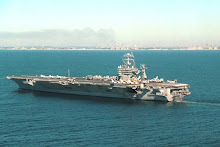In response to a request from Kanani during a Facebook discussion about the nuclear reactor in Japan that was damaged in the 03/11/11 earthquake, I'm including some information here about what is likely happening at that facility, based on my time operating nuclear reactor plants for the Navy.
This is just a basic overview of the situation in Japan, but please feel free to ask me any questions you have and I can include them and the answers here below the main post.
****
What's going on is known as a LOCA--loss of cooling accident. Though the reactor is safely shut down it continues to produce decay heat from residual fission reactions that can take days to weeks to dissipate depending on how long they were at full power prior to shutdown. The plant would have an emergency cooling backup system that should take over, but if both systems were physically damaged from the quake then not enough coolant is being circulated to keep the core cool.
The coolant in many reactors is extremely pure water that has a high concentration of deuterium--a heavy hydrogen isotope. The good thing about heavy water is that as it gets hotter, the molecules spread out and fewer neutrons are reflected back into the core to cause new fission reactions thereby moderating the reaction (slowing it down).
One of the byproducts of heavy water is that neutrons hit an H2O molecule or a deuterium molecule and knock free hydrogens which will make hydrogen gas (H2). This gas collects at high points and must be vented periodically to keep the levels below the explosive threshold. Its likely when they talked about mild radioactive release they were referring to the gases that are building up and also some coolant in steam form. Radioactive gases are like Radon--they have short half-lives and dissipate quickly by the wind and dilution. They would pose no health hazard and wouldn't cause any "fallout" or stick around forever. Common radioactive gases formed in reactor coolant are Hydrogen, Nitrogen, Krypton, Xenon, and Oxygen. These elements in their normal form are stable. However they can become radioactive after being bombarded by high-energy particles from the core which in essence "supercharge" them.
The bad thing is that a LOCA is a catch-22. As the coolant heats the pressure goes up. You have to vent to keep pressure down but that causes more coolant loss which leads to more heatup, more pressure, more venting...ad nauseam! The solution is to add more coolant and obviously fix the problem. The end result without intervention is that spots of the core get too hot without proper cooling and the fuel plates/rods rupture allowing radioactive fuel particles into the water. THAT would be bad!
Basically, it's the China Syndrome...in Japan.
___________________________________________________________
Q: What is radiation?
A: Radiation is when energy is emitted from something in particles or waves. When you stand in front of your oven and you feel warmth, that is radiation in the form of heat energy. Nuclear radiation is a collection of neutrons (Hydrogen nucleii), gamma rays (photons), beta particles (free electrons), and alpha particles (Helium nucleii). When something is "radioactive" it means that it is in a higher energy state than normal or has a larger number of neutrons than it has normally and is emitting one or more of those four things. Those particles/rays have energy of their own and interact with other things by either physically bumping them, transferring the energy, or by ionizing--causing other particles to have a positive or negative charge they don't normally have.
Instant #2 Motocross Wallpaper
10 years ago







4 comments:
Nice, concise and simple description. It's too bad that so many of the talking heads on TV couldn't do a simple search for data like this before throwing out so much speculation.
Keep up the good work, shipmate!
Trust a Navy nuke to give you the straight scoop! Okay, question time: now they're talking about dumping sea water into the reactor to keep it cool, and that at least one of the rods has melted. Sounds to me like the plant is/will be permanently wrecked. True?
@AW1: any time, shipmate! Thanks for stopping by.
@Storypainter: thank you as well for taking the time to read this. I haven't had time this morning to troll the news and suss out new info so I appreciate the details. If they are indeed injecting seawater directly in then yes, in my opinion the core is das kaput. As I had said, a likely outcome in a LOCA without drastic and speedy intervention is a fuel plate/rod rupture. I'll include your question and a more detailed answer in the Q and A update on the post. Thanks again!
--Squid
*GREAT* post Mate. Minor nit tho on your explanation of radiation. Neutrons are one of the *BASIC* particles making up matter. A hydrogen nucleus is really a *PROTON* I *KNOW* you know this...prolly just didn't watch your fingers close enough as you typed.
They are adding boron poisoned sea water to the reactors (1 and 3) to cool them down. I *WISH* that the talking heads would "get" that a nuclear explosion is *IMPOSSIBLE* at the enrichment levels present in the fuel of these reactors. Yes...they explode...hydrogen/steam explosions are a whole 'nother thing.
*HOPEFULLY* the techs there can keep the core cool enough to avoid a fuel breach. The heavier nasties will *NOT* disperse/decay as fast and make a *MUCH* bigger and long lasting mess.
*KUDOS* Mate...good info...and I know you want to be putting out *GOOD* info.
ET2/Reactor Operator - Submarine *MANY MANY* moons ago
Post a Comment